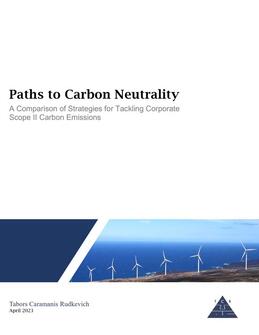April 2023 - Updated June 2023
|
Global climate change has pushed carbon emissions to the forefront of public scrutiny and scientific inquiry. Striving to reduce their net carbon footprint, large energy consumers have increasingly turned to renewable energy resources. These energy consumers have pioneered different approaches toward clean energy procurement, such as the RE100 initiative, Google’s 24/7 Carbon-Free Energy, Microsoft’s 100/100/0 vision, and the Emissions First partnership led by Meta and Amazon. This white paper examines different clean energy procurement strategies in terms of overall cost and effectiveness in carbon emissions reduction.
Using locational marginal emission rate (LMERs), we quantify the cost and carbon emissions impact of clean energy procurement strategies for corporate energy consumers with varying load shapes and within a variety of balancing authorities. We compare energy matching strategies against a strategy that directly accounts for carbon emissions, which we call carbon matching, for two different types of large electricity consumers in 5 different balancing authorities. Balancing authorities ranged from large ISO/RTOs (PJM and CAISO) to vertically integrated utility regions covering a regional (Duke Energy Carolinas) or municipal area (Los Angeles Department of Water and Power and Portland General Electric).
The results show the following:
Updated June 2023 to reflect revised storage cost assumptions Related Publications
Using marginal emission rates to optimize investment in carbon dioxide displacement technologies November 2021 | Electricity Journal Marginal Emission Rates - The Needed Metric of Carbon Displacement in an Increasingly Electrified World July 2021 | IEEE Power and Energy Society Displacing Carbon Emissions in the Power Section: How to more than double emission reduction from investments in clean electric resources May 2021 | TCR White Paper Methodology for Calculation of the Marginal Emission Rates from a Complex Cogeneration Facility compared with that of the co-located NYISO Bus January 2021 | Hawaii International Conference on System Sciences What Does it Take to Achieve Carbon Neutrality in the Electric Network? June 2020 | FERC Technical Conference |
|


